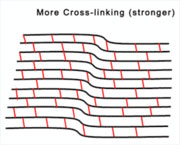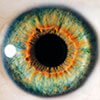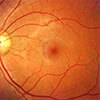Keratoconus
Thinning Cornea Causes Blurry Vision for Keratoconus Patients
Keratoconus (often referred to as ‘KC’) is a condition associated with thinning and distortion of the cornea, which is the front clear surface of the eye.
Keratoconus occurs in approximately 50-200 out of every 100,000 people. Keratoconus may run in the family and can occur as an isolated condition or may be associated with other eye conditions or general health problems including aniridia, retinitis pigmentosa, Down syndrome and Marfan syndrome. Keratoconus typically first appears in individuals who are in their late teens or early twenties, and may progress for 10-20 years, and then slow or stabilize.

Normal corneal symmetry on the left, and abnormally-shaped cornea with keratoconus on the right.
As the cornea becomes too thin in keratoconus, the surface of the cornea becomes uneven and vision may become blurry. This is a condition that generally affects both eyes but one may be more severely distorted than the other.
In the early stages, people might experience slight blurring of vision, distortion of vision and/or increased sensitivity to light. Patients who wear contact lenses may find that their contacts do not work well and do not seem to fit properly. Vision may also appear blurred with glasses.
Over time, progressive thinning of the cornea may lead to blurred vision that cannot be corrected by contact lenses or glasses.
You can find more information from the National Keratoconus Foundation at www.NKCF.org
Surgical treatments are available for keratoconus:
- Collagen crosslinking
- Intrastromal corneal ring segments or INTACS®
- Corneal transplantation with a Femtosecond laser
- Partial thickness cornea transplants (DALK – Deep Anterior Lamellar Keratoplasty)
Keratoconus Treatments Offer Relief
Surgical treatments are available for keratoconus: Corneal cross-linking, Intrastromal corneal ring segments (INTACS®), corneal transplantation with a Femtosecond laser, and partial thickness cornea transplants (DALK – Deep Anterior Lamellar Keratoplasty).

Cross-linking increases the number of collagen bonds in the cornea to add strength and keep its shape.
Corneal Cross-linking (CXL or KXL)
Corneal Collagen Cross-linking (CXL or KXL) is a technique that uses advanced technology to treat patients with keratoconus, pellucid marginal degeneration and post LASIK ectasia. The two cross-linking procedures (KXL and CXL) use the B vitamin riboflavin and ultraviolet light to strengthen the stromal layer of collagen in the cornea. Collagen cross-linking, a minimally invasive outpatient procedure, can prevent the need for a corneal transplant.
NWES has been offering cross-linking since 2012. KXL is FDA approved. First, the eye is numbed, then some of the top layer of the cornea is removed and the riboflavin is administered. Then the UV light is applied to activate the riboflavin. A bandage contact lens is used after the procedure is completed so the top layer of the cornea can heal. CXL is not FDA approved at this time. The top layer of the cornea remains intact for this procedure. The cornea is saturated with the riboflavin, then the UV light is applied. Below is a video of the CXL procedure.









